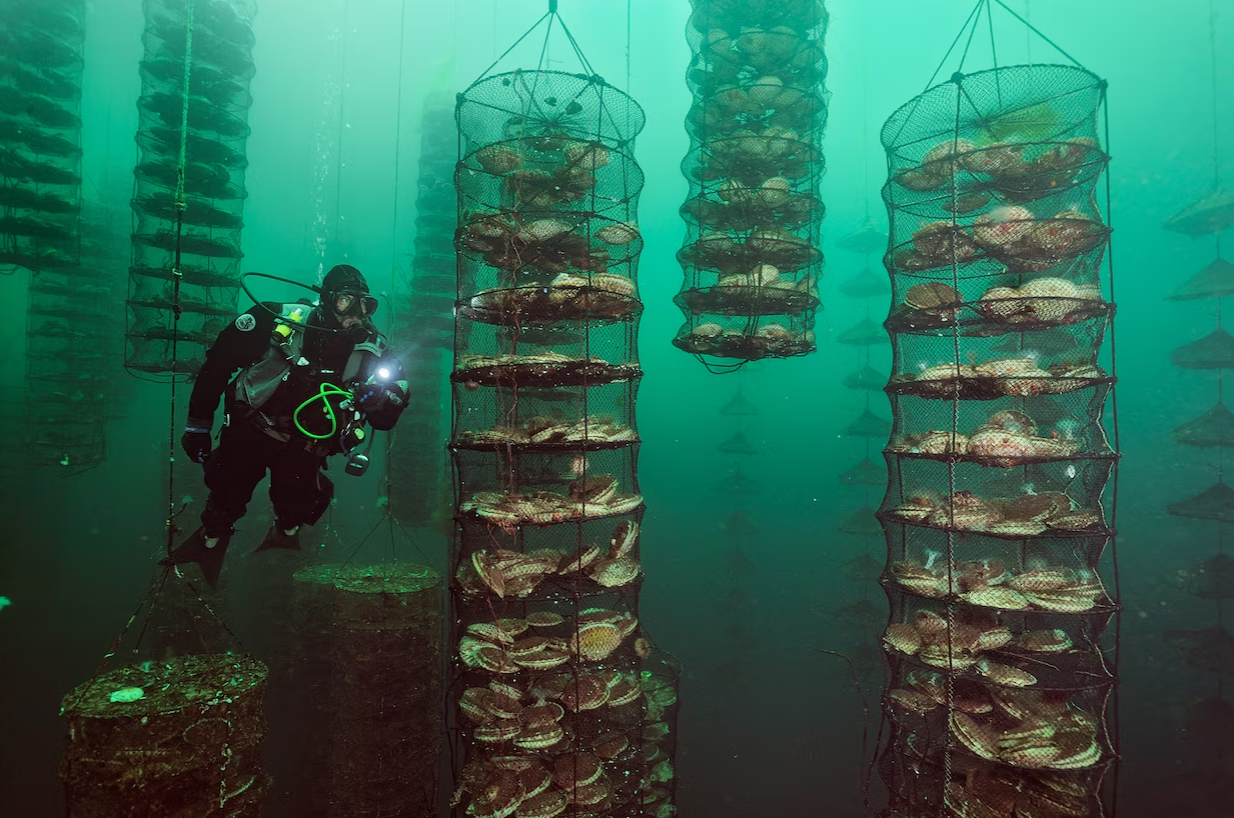A Brief Explanation of Aquaculture and Ocean Farming Methods
Agriculture and farming – endless fields of wheat, corn, and livestock – have long been an essential part of human survival and are irreplaceable as a food production system. But what if it was possible to move food production underwater? What would harvesting aquatic plants and marine wildlife look like? In fact, aquatic food production already exists and is an industry poised to grow and meet increasing demand for environmentally friendly food.
A picture of a farm of Giant Japanese scallops.
Aquaculture is the process of breeding, rearing, and harvesting fish, plants, and other organisms in a controlled water environment. This can happen in nearly any body of water, including ponds, rivers, lakes, oceans, and even man-made systems (3). Ocean farming has existed since 500 BCE but only expanded commercially during the 20th century (1). The purpose of aquaculture extends far beyond just food production; it can be used to rebuild populations of endangered species, restore habitats, enhance wild stocks, produce baitfish, and provide fish for zoos and aquariums (3).
There are three major types of aquaculture: algae, shellfish, and finfish. The first type, algae aquaculture, generally involves seaweed farming because seaweed is so easy to cultivate. Seaweed is grown on longlines (horizontal ropes) that are submerged a few feet below water. Seaweed has a two-month harvesting period, and at the end of this period, the longlines are pulled up and the seaweed is cut off the ropes (4). Seaweed farming is beneficial to the environment; it produces low levels of carbon emissions, and seaweed absorbs carbon dioxide, nitrogen, and phosphorus from the water, enhancing the overall condition of its marine environment (7).
Shellfish aquaculture, as its name suggests, involves farming oysters, clams, and mussels. In shellfish aquaculture, farmers first obtain the seedlings from a hatchery, then place them in a farm underwater. The farming environment for each shellfish is a bit different: mussels are usually grown near the water surface on hanging ropes; oysters are cultivated in bags/cages that float in the water; and clams grow at the ocean floor, where they will burrow themselves in the sand out in the open or in bags (4).
Finfish aquaculture is the most complicated type of ocean farming, and is best done in a closed system or an outdoor pond instead of in the open ocean (8). It involves diverse types of fish such as salmon, catfish, and tilapia. Depending on each fish’s unique needs, the farm may need to adjust its temperature, salinity, or location, which can become complex and expensive. Negative impacts to the environment may occur when nutrients in the fish farm are not consumed or cycled (for example, uneaten feed or fish wastes), which is why farmers need to precisely control the aquatic environment in order to raise a healthy population of fish and maintain a clean ecosystem (9, 4).
Aquaculture is a valuable source of food, producing almost 50% of all seafood consumed by humans worldwide; however, US aquaculture only supplies about 5% of Americans’ consumed seafood supply (3). The rest of the seafood consumed in the US is mostly imported from countries like Canada, Chile, India, Indonesia, and Vietnam (6). Promoting ocean farming could help alleviate the money spent annually on these imports in the US (3).
A picture of a finfish farming site.
Aside from producing food, aquaculture can also be a solution to overfishing. Humans have exploited generations of wild fish, and the ocean can no longer naturally provide sufficient seafood to meet human demands. And that’s exactly where aquaculture comes in: ocean farming is a sustainable and efficient solution to meet seafood demand, while also being environmentally friendly with minimal greenhouse gas emissions. Aquaculture, if done responsibly and ethically, has the power to improve the health of our planet’s oceans in the future. Such great benefits can be obtained from simply farming underwater (5)!
Bibliography:
- Amundson, C. H., & R.F.T, A. (1999, May 3). Aquaculture | Definition, Industry, Farming, Benefits, Types, Facts, & Methods. Retrieved January 22, 2025, from https://www.britannica.com/topic/aquaculture
- US. (2025). What is aquaculture? Retrieved January 22, 2025, from https://oceanservice.noaa.gov/facts/aquaculture.html
- What is aquaculture? (2016). Retrieved January 22, 2025, from https://www.noaa.gov/stories/what-is-aquaculture
- Farrow, H. (2023, April 14). What is aquaculture? It may be the solution to overfishing. Retrieved January 22, 2025, from https://www.nationalgeographic.com/environment/article/aquaculture-explainer-seaweed-fish-benefits-challenges
- Cassidy, M. (2019, March 27). What is Aquaculture, and Why Do We Need It? Retrieved January 22, 2025, from https://www.globalseafood.org/blog/what-is-aquaculture-why-do-we-need-it/
- U.S. Seafood Imports Expand as Domestic Aquaculture Industry Repositions Itself | Economic Research Service. (2024). Retrieved February 6, 2025, from https://www.ers.usda.gov/amber-waves/2024/may/u-s-seafood-imports-expand-as-domestic-aquaculture-industry-repositions-itself#:~:text=The%20total%20value%20of%20U.S.,and%20Vietnam%20(6.4%20percent)
- NOAA Fisheries. (2024). Seaweed Aquaculture. Retrieved February 6, 2025, from https://www.fisheries.noaa.gov/national/aquaculture/seaweed-aquaculture
- Aquaculture Fin Fish Species. (2022). Retrieved February 6, 2025, from https://www.agmrc.org/commodities-products/aquaculture/aquaculture-fin-fish-species
- NOAA Fisheries. (2024). Nutrient Impacts of Finfish Aquaculture. Retrieved February 6, 2025, from https://www.fisheries.noaa.gov/aquaculture/nutrient-impacts-finfish-aquaculture
Images:

